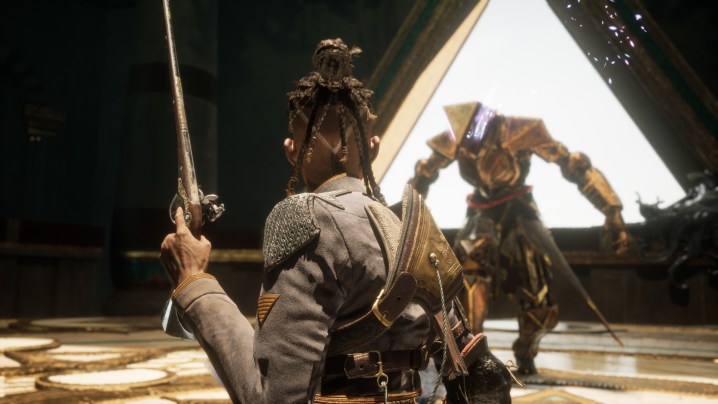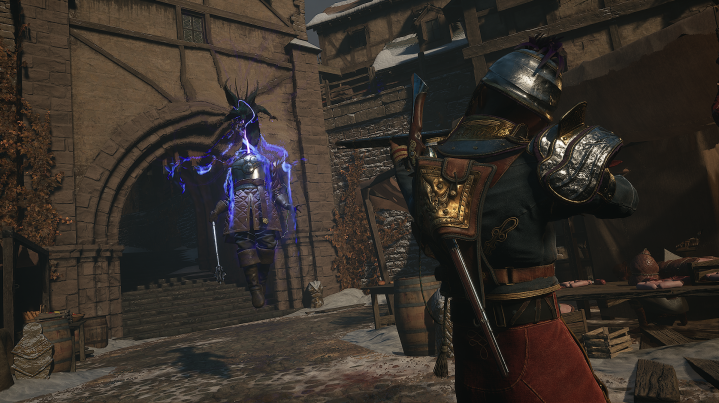
As I played through a demo of Flintlock: The Siege of Dawn, a fast and furious new action RPG, I felt a small yearning. I’m still waiting for the Soulslike genre to have its Spelunky moment.
In 1980, a game called Rogue released, and it left a lasting impact because of its unique structure. If players died, it wasn’t possible to reload a save and continue playing through that same adventure; instead, the dungeon would be procedurally generated and players would have to start fresh with a new character. This would go on to inspire a genre of games called “roguelikes,” but that genre truly came into its own decades later thanks to Spelunky.
Game designer Derek Yu discovered that the core design philosophies that made Rogue special weren’t restricted to its specific gameplay style. Spelunky recontextualized the ideas of randomized runs and punishing deaths that encourage players to get better from Rogue to a 2D platformer. In doing so, Yu exposed a whole new group of players to the engrossing gameplay loop that the original Rogue uncovered and created a new genre. Now, roguelikes and roguelites are a massive genre full of diverse games, from Balatro to The Rogue Prince of Persia.

The Soulslike is now a full-fledged subgenre too, as FromSoftware forged a challenging but rewarding design loop through Demon’s Souls and Dark Souls. The formula encourages players to learn mechanics, get better, and overcome the tough enemy keeping them down. I love that FromSoftware’s games have had that effect, but my biggest problem with Soulslikes is that they all look and feel too much like Dark Souls. Many Soulslikes adopt similar control schemes, camera perspectives, and combat to FromSoftware titles when they could be applying that design to new and unexpected genres or styles of control.
When A44 started to refer to its new game, Flintlock: The Siege of Dawn, as a “Soulslite,” I had hoped the studio had finally cracked the code and given the genre its Spelunky moment. That is very much not the case, even if Flintlock adds its own flourishes with guns and more fast-paced platforming and combat. While I’m sure fans of Dark Souls will enjoy Flintlock, I can’t help but think of all the players put off by Soulslikes who could discover the beauty of the formula if a game redefined Dark Souls as Spelunky did to Rogue.
Still a Soulslike
Flintlock takes place in what A44 calls a “gunpowder fantasy” world. Imagine if Game of Thrones took place around World War I. This gives the game a unique aesthetic and gun-powered flair to combat. Players can shoot their flintlock pistol to stun them mid-attack animation or fire at enemies with a rifle from afar and use a gunpowder blast to break a long fall. There’s also the godlike companion with its own moves and a combo system that can increase how much Reputation — Flintlock’s versions of Souls — players receive.

A44 believes that this more frenetic gameplay, colorful aesthetic, and combo system give Flintlock enough of a distinct flavor to call it a Soulslite rather than a Soulslike. Although I do think what I played of Flintlock is solid, the Soulslite labeling doesn’t feel quite right. While gameplay speed can increase, the cadence of attacking, blocking, dodging, and parrying always feels the same. Flintlock adopts that and similar controls to Dark Souls; the only real differences are that I can sometimes interrupt enemies with a gunshot and the world I’m fighting in is much more colorful.
As I play, I just can’t help but wish that Soulslikes were getting even more experimental and ambitious. To be fair, I think games like Flintlock are laying the groundwork for that. A44 is proving that Soulslike combat shouldn’t just be restricted to swords and magic. Stellar Blade blended in elements of character action games like Devil May Cry, while Another Crab’s Treasure was almost as much of a 3D platformer as it was a Soulslike. All of these games also aren’t afraid of difficulty, which inherently makes them a bit more accessible than Dark Souls.
While I do appreciate that Soulslikes are trying to make themselves stand out from the Souls games more, none of them have gone all the way like Spelunky did for its own genre. All Soulslikes are inherently derivative of FromSoftware’s work, but I think there’s still more room for ambitious game designs to explore and expand the concept of what a Soulslike or Soulslite could mean. In fact, FromSoftware seems to be the only studio that can top itself by transforming Dark Souls’ mechanics to work in a parry-focused game like Sekiro: Shadows Die Twice, a mecha game with Armored Core VI, and an open-world adventure like Elden Ring.

Souls games don’t click with players just because they control a certain way and have a certain cadence to battles. They stick with me because of the constant push and pull. I get great feelings of shame when I fail and of victory when I overcome a tough opponent. I keep playing because we know we have to get back to a certain point of proven skill or be punished, not because it’s our Souls or something synonymous with it.
I don’t know what exactly that looks like in something like a platformer, strategy game, or card game, but the game designer who cracks that code could take Souls-inspired games to the next level. When that happens, then I think we can start throwing the term Soulslite around. Until then, Flintlock: The Siege of Dawn doesn’t quite feel like it’s standing out from the crowd as much as it intends to. That might be great news for genre purists, but the full game will need to take its ideas one step further to really impress me.
Flintlock: The Siege of Dawn launches later this year for PS5, Xbox Series X/S, and PC.



